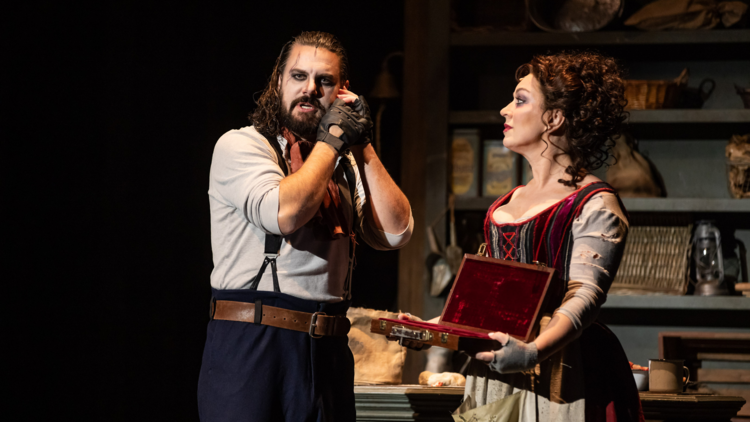Sweeney Todd: The Demon Barber of Fleet Street - Sydney Opera House (NSW)
Music & Lyrics by Stephen Sondheim. Book by Hugh Wheeler. Directed by Stuart Maunder AM.
Reviewed by Kate Gaul
Drama Theatre, Sydney Opera House
22 July - 27 August 2023 Tickets: https://www.sydneyoperahouse.com/musical-theatre/sweeney-todd
3 STARS
- The bloody tale of Sweeney slices its way into the Sydney Opera House, sacrificing its female characters in the process -
Sweeney Todd: The Demon Barber of Fleet Street is a musical by Stephen Sondheim and Hugh Wheeler. The latest Australian production is Victorian State and New Zealand Opera Production presented by the Sydney Opera House as part of its fiftieth-year celebrations.
It’s about a barber named Benjamin Barker (Ben Mingay) who returns to London under the name of Sweeney Todd, after having been exiled to Australia by the corrupt and powerful Judge Turpin (Dean Vince). The judge is cruel and possessive, raping Todd’s wife (now presumed dead) and taking legal ownership of Todd’s young daughter, Johanna (Ashleigh Rubenach), who he later tries to marry.
Sweeney Todd: The Demon Barber of Fleet Street. Sydney Opera House. Images by Daniel Boud.
Todd, with a thirst for blood and vengeance, meets a struggling pie shop owner, Mrs. Lovett (Antoinette Halloran). Together, the two enter a curious business partnership in which Todd shaves men close enough to end their lives and Lovett bakes them into the meat pies she sells to unwitting customers, revitalizing business for both and giving Todd a chance to exact deadly revenge on the judge and his beadle (Kanen Breen).
In Sweeney Todd, the act of cooking slain humans into pies to sell during a meat shortage is presented not as an unfathomably evil act but as a feasible way to make a living when “times is hard, sir.” Eating the rich denotes a desire to destroy an oppressive upper class and emancipate oneself from capitalism. In Sweeney’s case, when you have a shop to run, demand to keep up with, and money to make, the rich aren’t the only ones being consumed. In a desperate attempt to get revenge and make a decent living and recover their respective sense of “integrity”, Todd and Lovett end up literally privileging profit over personhood.
It’s not just the book and lyrics of Sweeney Todd that hint at the oppressive nature of class. Directed by Stuart Maunder, designed by Roger Kirk with lighting design by Philip Lethean the stage is a gloomy world of shadowy levels and faux metal structures that hint at an industrial revolutionary London. The working-class costumes work well on a small ensemble and the principals’ splashes of electric colour point to a parallel world of money and - if not taste – then opulence. Lovett’s costuming becomes more elaborate as her fortunes grow.
The characters are more or less fairly stereotypical of this kind of work. No more so than the women. I wondered how many women directors may have approached this piece and whether there might be a difference in the rendering of this half of the world. As Mrs Lovett, Halloran has plenty of vim but there is scope for more nuance. Mrs Lovett is a strange and complicated lady. In this production she never seems to fear Sweeney although he is clearly dangerous (played with great relish by Mingay). As her name suggests she seeks love and longs for Sweeney even when it is unrequited. But they reveal themselves well suited by the end of act one and their psychotic schemes in the rambunctious finale: “A Little Priest”.
In Act 2, Halloran revealed a touching maternal relationship with the shop apprentice Tobias Ragg (Jeremi Campese) in the heart-breaking “Not While I’m Around”. Tobias, one of the few survivors of the show's carnage, is left consumed by a tormented grief of familial loss.
Then something unexpected happens – Sweeney discovers that the beggar woman he murders is his wife who was raped and stolen from him all those years earlier by the evil Judge Turpin (now also dead). He cradles her corpse in his arms, sobbing, unable to let go. It initially makes no sense and even with the musical’s pedigree one smiles at the speedy wind up.
Beggar Woman (Margaret Trubiano) is a suffering stranger in rags and smudgy makeup who is constantly shunned and pushed off stage. Never allowed to genuinely hover around the fringes of the action. She’s derelict and a kind of jokey feral to stand in for the disenfranchised and bereft. We are never given one hint that she may have something more at stake. I wonder what might have been the result of giving an equal weight to this female character rather than the stereotypical second to the man’s story. I think it could be achieved without sentimentality.
As it is, we rely on Mingay’s brooding presence and commanding voice to reveal the pathos of this moment and the dark heart of this work: the story of a man’s revenge against society that destroys his wife and daughter.
Sweeney Todd: The Demon Barber of Fleet Street
CAST
Sweeney Todd Ben Mingay
Mrs Lovevtt Antoinette Halloran
Anthony Hope Harry Targett
Johanna Ashleigh Rubenach
Tobias Ragg Jeremi Campese
Judge Turpin Dean Vince
The Beadle Kanen Breen
Beggar Woman Margaret Trubiano
Signor Pirelli/Jonas Fogg Benjamin Rasheed
Ensemble Rachael Cunningham, Jarrod Griffiths, Michaela Leisk, Katie McKee, Jessica Mills, Joshua Robson, Anna Stephens, Louis Vinciguerra, Elias Wilson.
ORCHESTRA Conductor Simon Holt
Keyboard Craig Renshaw
Violin Heather Burnley Cello Steve Meyer Double Bass Mark Harris Clarinet Ian Sykes Bassoon Jack Cremer Horn Ben Jacks Trumpet Sophie Spencer Percussion Blake Roden
CREATIVES
Music & Lyrics by Stephen Sondheim
Book by Hugh Wheeler
From an Adaptation by Christopher Bond
Originally Directed by Harold Prince
Orchestrations by Jonathan Tunick
Originally Produced on Broadway by Richard Barr, Charles Woodward, Robert Fryer, Mary Lea Johnson, Martin Richards, In Association with Dean and Judy Manos
Licensed exclusively by Music Theatre International (Australasia)























